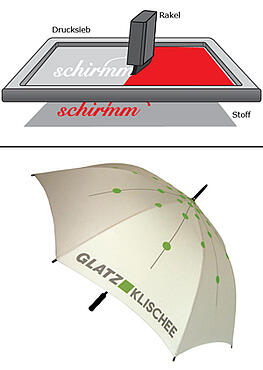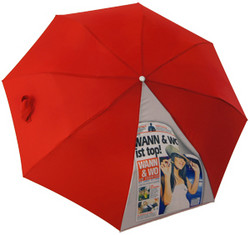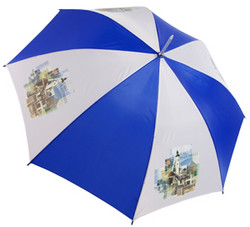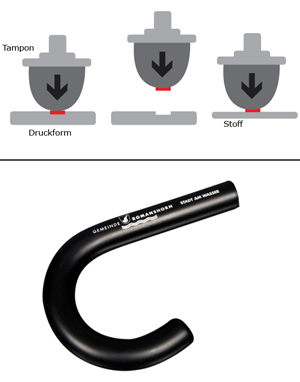Printing techniques for umbrellas
Different textile printing techniques are used when printing on umbrellas. There are different requirements for the print depending on the design and the product. Schirmmacher offers a wide range of different techniques and can therefore get the most out of any promotional umbrella project.
Hand screen printing
The requested print design is first printed onto a film (transparent foil). The film is then placed on a printing screen with a polymer layer. The film and screen are then irradiated with UV light. This hardens the exposed areas of the fabric and makes them impermeable to ink, while the unexposed areas can simply be washed out.
The resulting screen is placed like a stencil on the fabric to be printed. With a so-called squeegee, the ink can now be brushed through the permeable areas of the screen, transferring the logo directly onto the fabric.
Advantages:
- Can be used for small quantities
- High lightfastness
- Long durability
- Relatively high colour fidelity
- Ideally suited for most logo designs
Disadvantages:
- Only possible on stock fabrics
- Colour gradients are problematic
- No photo printing possible
- Can only be used to print on certain areas

Digital printing (sublimation printing)
In sublimation printing, a special foil is printed in reverse and the design is then transferred to the fabric using a heated transfer press. In sublimation printing, the applied ink cannot be perceived haptically because the ink is absorbed directly into the material.
Advantages:
- Designs in photo quality
- Colour gradients possible
- Printing possible even for small quantities
- Can be used as all-over printing
Disadvantages:
- Printing only possible on a white background
- Danger of staining with certain colour combinations
- The printing effort for large quantities is relatively large
- Fairly high colour deviations possible

Special printing techniques for umbrellas
Foil transfer printing
As with sublimation printing, the design is first printed onto a carrier film. The design is then transferred to the fabric through a heat process. Unlike sublimation printing, the design is glued on rather than absorbing into the fabric.
Advantages:
- Any designs and colour combinations possible
- Designs in photo quality
- Colour gradients possible
- Printing possible even for small quantities
- Printing on any fabric colours
Disadvantages:
- The print design becomes relatively hard
- The print design cannot end with a colour gradient at the edge
- The printing effort for large quantities is relatively high
- Can only be used to print on certain areas

Tampo printing
The design is transferred from one surface to the other using a silicone pad. Uneven surfaces, such as the umbrella handle, can also have printing on them. A printing form with indentations is created for this purpose. The ink is then absorbed by the pad and printed onto the object.
Advantages:
- Can also be used for small quantities
- Long durability
- Relatively high colour fidelity
- Can also be printed on colour backgrounds
Disadvantages:
- No colour gradients possible
- The number of colours is limited
Tampondruck
